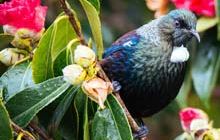Grey warbler/riroriro
Introduction
The grey warbler is a relatively inconspicuous grey bird that flits about the canopy of the forest but its call permeates the forest and takes the edge off a hard uphill slog for any attentive tramper.New Zealand status: Endemic
Conservation status: Not Threatened
Found in: Throughout New Zealand
Species information: Grey warbler/riroriro on NZ Birds Online
These diminutive insectivorous birds busy themselves along branches seeking out small invertebrates.
Grey warbler (Gerygone igata) was the surprise recipient of the title of New Zealand's best-loved bird in 2007.
Facts
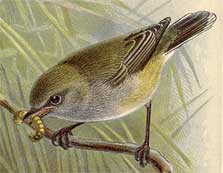
Grey warbler perched on a branch
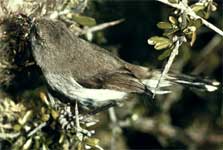
Grey warbler
The grey warbler/riroriro are found throughout New Zealand.
They are a small grey-brown bird with pale grey on the face throat and breast and an off white belly and under tail.
Weighing about 6.5g, which is around one-third the weight of a mouse, makes them one of New Zealand's lightest birds.
They are insectivores with a habit of hovering to pick insects and spiders from plants.
Grey warblers are clever nest builders. They have distinctive domed hanging nests with a small side entrance hole.
They are one of few native passerines to have benefitted from human modification of the landscape.
Sound recording
Grey warbler song (MP3, 527K)
01:26 – Territorial call, flying between perches, answering a tape recorder.
Our bird songs can be reused, even commercially, according to our copyright terms.
"People call grey warblers dull, but they're the subconscious sound of New Zealand."
– Graeme Hill, Campaign Manager for the grey warbler in Forest & Bird's 2007 New Zealand's bird of the year competition
"In the warm sunlight of advancing summer, when the manuka-scrub is covered with its snow-white bloom and the air is laden with the fragrance of forest flowers, amidst the hum of happy insect-life, a soft trill of peculiar sweetness—like the chirping of a merry cricket—falls upon the ear, and presently a tiny bird appears for an instant on the topmost twigs of some low bush, hovers for a few moments, like a moth before a flower, or turns a somersault in the air, and then drops out of sight again. This is the Grey Warbler, the well-known Riroriro of Maori history and song."
– Sir Walter Lawry Buller, A History of the Birds of New Zealand, 1888, London
Threats
Grey warblers are abundant and widespread and no threat to their long term existence is apparent.
Our work
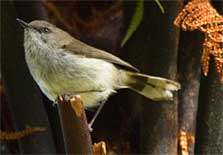
Grey warbler in a tree fern
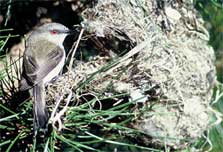
Grey warbler at nest
Grey warbler/riroriro are not threatened, so DOC doesn't actively work with them.
Of course, the work that DOC does in plant and animal pest control increases the quality of whole ecosystems, and therefore contributes to the ongoing success of many common birds like the grey warbler, as well as ensuring the ongoing survival of our rarer more susceptible species.
DOC priorotises its work to protect the rarer species, in the context of their overall environment. This is encapsulated in the whakatauki (Maori Proverb):
"Tiakina nga manu, ka ora te ngahere Ka ora te ngahere, ka ora nga manu"
"Look after the birds and the forest flourishes. If the forest flourishes, the birds flourish."
You can help
Grey warblers are quite common, although they are relatively shy and are heard more than seen. They will quite likely visit your garden if you plant native shrubs for them to safely build their nests in.
Emergency hotline
Call 0800 DOC HOT (0800 362 468) immediately if you see anyone catching, harming or killing native wildlife.
On your property
- Trap predators on your property.
- Be a responsible cat owner.
In your community
- Find and volunteer with your local community group
- Trap predators in your community
- Get kids or schools involved
See Predator Free 2050 Trust - get involved for information.
Visiting parks, beaches, rivers, and lakes
- Leave nesting birds alone.
- Use available access ways to get to the beach.
- Avoid leaving old fishing lines in the water.
- Follow the water care code and local navigation bylaws.
- Do not drive on riverbeds, or keep to formed tracks if you have to.
- Check for pests if visiting pest-free islands.
With your dog
- Only take dogs to areas that allow them, and keep them under control.
- If you come across wildlife put your dog on a lead and lead it away.
- Warn other dog owners at the location.
- Notify DOC if you see wildlife being harassed by people or dogs.
- Get your dog trained in avian awareness.
- Learn about the Lead the Way programme which encourages dog owners to become wildlife wise and know how to act to protect coastal wildlife.
Specific ways to keep wildlife safe while with your dog on beaches.

